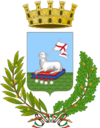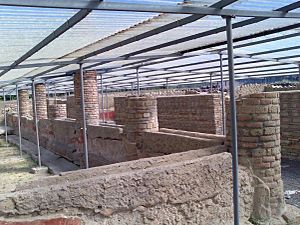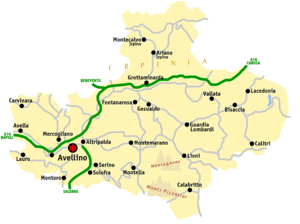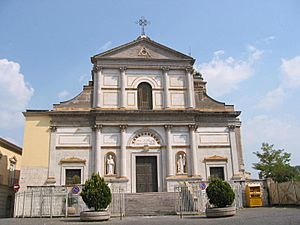Avellino facts for kids
Quick facts for kids
Avellino
|
|||
|---|---|---|---|
| Comune di Avellino | |||
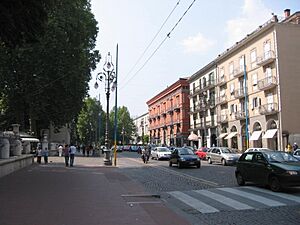
Corso Vittorio Emanuele
|
|||
|
|||
| Country | Italy | ||
| Region | Campania | ||
| Province | Avellino (AV) | ||
| Frazioni | Bellizzi Irpino, Pianodardine, Picarelli, Valle-Ponticelli | ||
| Area | |||
| • Total | 30.55 km2 (11.80 sq mi) | ||
| Elevation | 348 m (1,142 ft) | ||
| Population
(31 March 2017)
|
|||
| • Total | 54,515 | ||
| • Density | 1,784.45/km2 (4,621.7/sq mi) | ||
| Demonym(s) | Avellinese | ||
| Time zone | UTC+1 (CET) | ||
| • Summer (DST) | UTC+2 (CEST) | ||
| Postal code |
83100
|
||
| Dialing code | 0825 | ||
| Patron saint | St. Modestinus | ||
| Saint day | 14 February | ||
Avellino is a city in southern Italy. It is the capital of the province of Avellino in the Campania region. The city sits in a flat area surrounded by mountains. It is about 47 kilometers (29 miles) east of Naples. Avellino is an important meeting point for roads connecting cities like Salerno and Benevento.
Contents
History of Avellino
Ancient Times
Before the Romans arrived, an ancient town called Abellinum was located near what is now Atripalda. This town was home to the Hirpini, a group of people called Samnites. The Romans took control of Abellinum in 293 BC.
The Romans built a new town in 82 BC. It was called Veneria Abellinatium. This new city had strong walls and a well-planned layout. Later, in 7 AD, the Roman emperor Augustus renamed it Livia Augusta. This was to honor his wife, Livia Drusilla.
In the 3rd century, Emperor Alexander Severus made the city even bigger. He called it Livia Augusta Alexandrina. Many people from the East moved there, bringing new customs and beliefs.
Middle Ages and Beyond
Over time, the city faced tough times. There were economic problems, strong earthquakes in 346 AD, and big volcanic eruptions in 472 AD. Around 500 AD, the city became Christian.
Later, groups like the Goths and Vandals invaded. After the Lombards took over southern Italy, the old city was left in 568 AD. A new town started to grow on a nearby hill, which is where modern Avellino is today.
This new Avellino had a castle for protection. It became part of important Italian states like the Duchy of Benevento and the Principality of Salerno. In 1100, during the time of Norman rule, a powerful family bought the rights to Avellino.
In 1581, Don Marino I Caracciolo bought the rights to Avellino. He became the Prince of Avellino in 1589. His family made Avellino their main home.
Modern Challenges
In 1820, Avellino saw some revolutionary protests. Later, when Italy became one country around 1870, Avellino did not benefit much. It was not on the main railway lines and was far from the sea.
During World War II, in 1943, Allied planes bombed the city. They were trying to stop German tanks from retreating over an important bridge.
Avellino has often been hit by earthquakes. Major ones happened on November 23, 1980, and February 14, 1981. The city has also received ash from eruptions of Vesuvius, a volcano to the west.
Economy
The 1980 earthquake changed Avellino's economy a lot. A lot of money came in for new buildings and roads. This helped the city grow and create new businesses. By 2008, people in Avellino earned more money on average than in other parts of the region.
Farming
Farming was very important to Avellino's economy until the 1970s. Since then, many young people have left farms to find other jobs. However, growing tobacco, making wine (viticulture), and especially producing hazelnuts are still key parts of the local economy. More money has been invested in these areas recently, creating jobs.
Factories and Industry
Manufacturing is also a big part of Avellino's economy. There are two main industrial areas on the edges of the city. Many small and medium-sized businesses are located here.
One important company is FMA (Fabbrica Motori Automobilistici). This factory makes car engines for brands like Fiat, Opel, Jeep, Lancia, and Alfa Romeo. They also created the "multi-jet" engine, which uses fuel injection.
Getting Around Avellino
Airports
The closest airports are Salerno-Pontecagnano, about 51 kilometers (32 miles) southwest, and Napoli-Capodichino, about 53 kilometers (33 miles) west.
Trains
Avellino's train station is located where the city meets Atripalda. It used to be a main stop for trains going to Benevento, Cancello, and Rocchetta Sant'Antonio. These trains helped connect Avellino with other cities.
In 2010, some train services were stopped. In 2012, most local train services were closed. But after protests from people who use the trains, a few services were brought back later that year.
Roads
Avellino is connected to the A16 highway by two exits (Avellino Est/East and Avellino Ovest/West). This highway runs from Naples in the west to Canosa di Puglia and Bari in the east. Near Naples, the A16 connects to the A3 highway, which helps people travel across Italy.
Another important road is the "Ofantina" superstrada (a dual carriageway). This road links Avellino with several important towns to the east and south, on the way to Salerno.
Public Transport
Public transportation in Avellino is run by a company called AIR Campania. Since 2023, the city has trolleybuses. These are like electric buses that get power from overhead wires. A new trolleybus route opened on April 3, 2023. Avellino actually had a trolleybus system before, from 1947 to 1973.
Sports
- U.S. Avellino 1912: This is the city's main football (soccer) club.
- S.S. Felice Scandone: This is a basketball club based in Avellino.
Main Sights
- Ancient Roman Ruins: The remains of the old Roman city, Abellinum, are near the modern village of Atripalda. You can see parts of the old town square (forum), temples, baths, and a large Roman house. There was also an amphitheatre for shows.
- Avellino Cathedral: This church has a Romanesque style crypt (an underground room). It was built on the site of an old Roman villa. The church and convent of Santa Maria delle Grazie were built in 1580.
- Lombard Castle Remains: You can find some parts of the old Lombard castle in Piazza Castello (Castle Square). It's interesting because the castle was built at the bottom of a small valley, which makes its purpose a bit of a mystery to historians.
- Fountain of Bellerophon: This beautiful fountain was made in the 17th century by an artist named Cosimo Fanzago.
Museums
- National Gallery of Selachoidei: This museum has one of the largest collections of cartilaginous fishes (like sharks and rays) in Italy.
- Museum of Art (MdAO): A place to see different kinds of art.
- Museum of the Cathedral and the Diocese of Avellino: This museum tells the history of the Avellino Cathedral and the local church area.
- Provincial Archaeological Museum: Here you can learn about the ancient history and discoveries from the Avellino area.
- Provincial Art Gallery: Located in the old "Carcere Borbonico" (Bourbon Prison), it displays various artworks.
- Zoological Museum of Invertebrates "L. Carbone": This museum focuses on animals without backbones, like insects and spiders.
Notable People
- Sonia Aquino (born 1977): An actress.
- Luigi Di Maio (born 1986): A politician.
- Carmine Biagio Gatti (born 1988): A football player.
- Carmen Giannattasio (born 1975): An opera singer.
- Maurizio Lanzaro (born 1982): A football player.
- Gianfranco Rotondi (born 1960): A politician.
Images for kids
See also
 In Spanish: Avellino para niños
In Spanish: Avellino para niños



